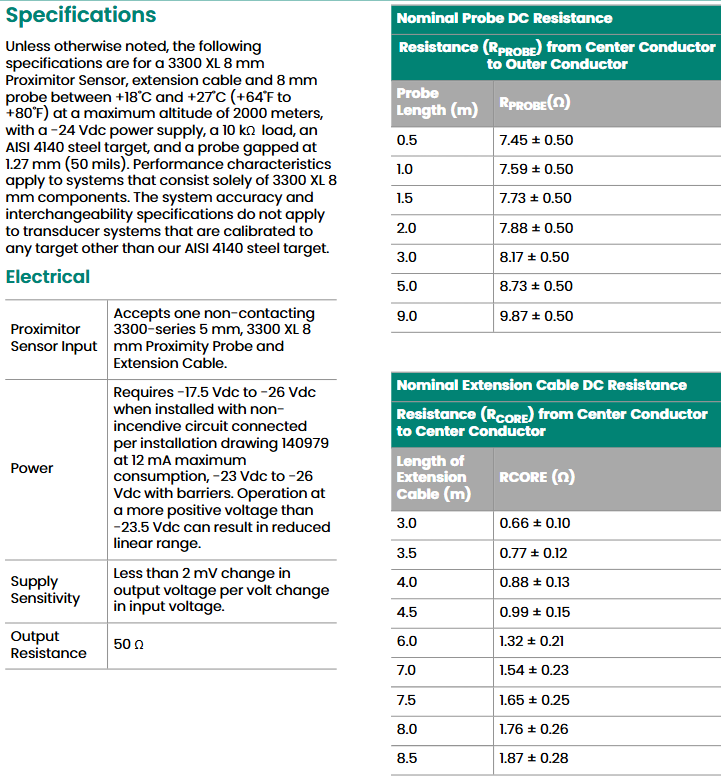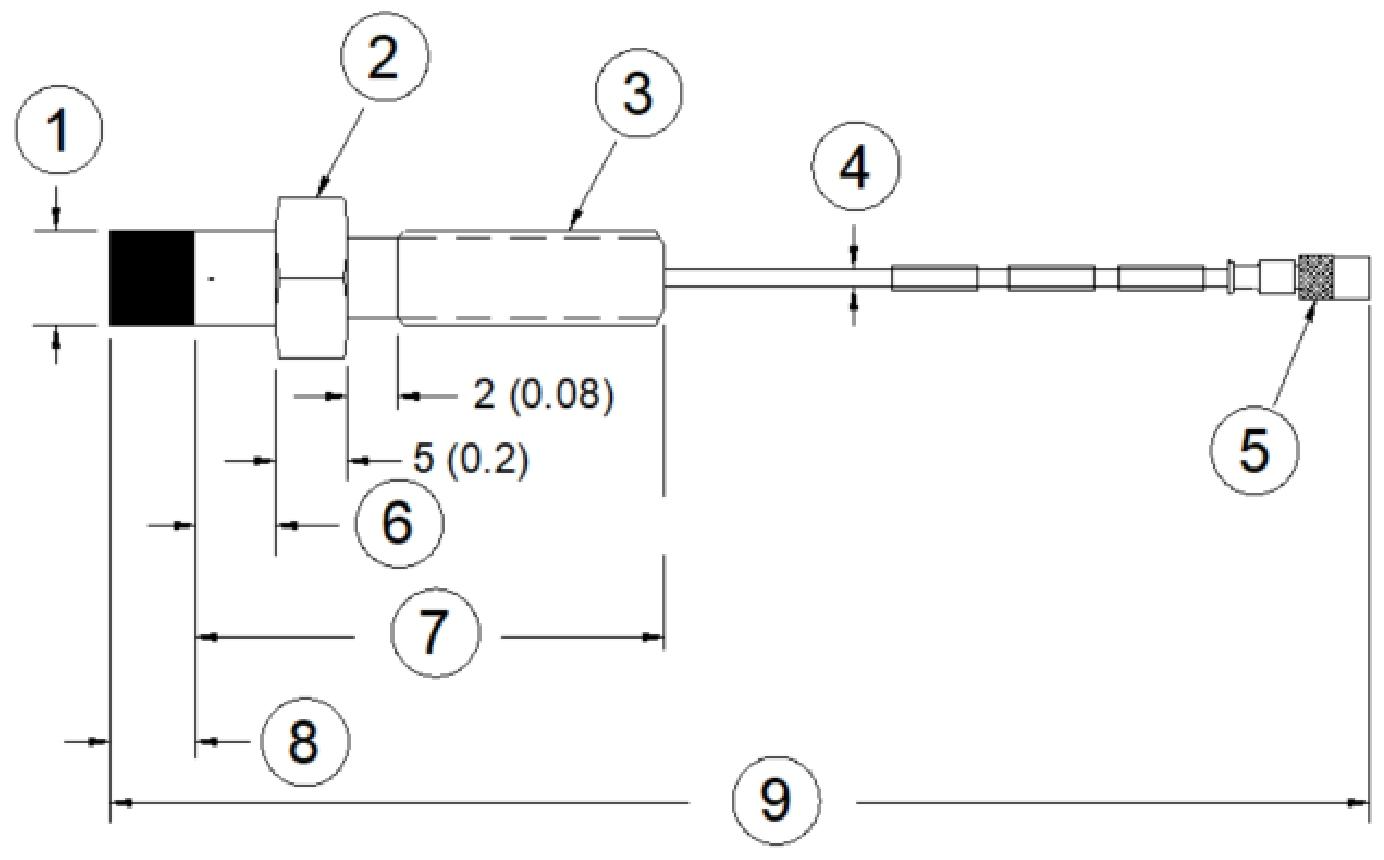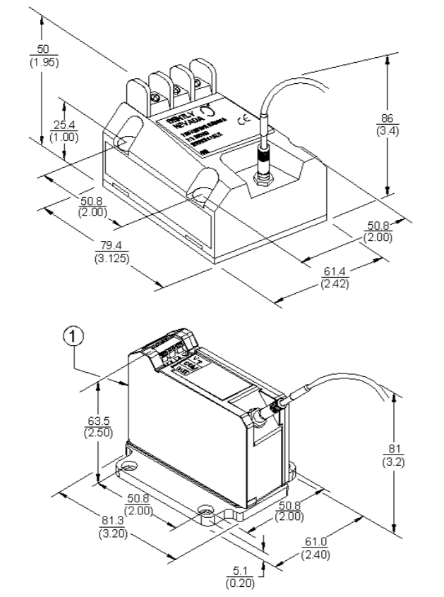

K-WANG


Bently 3300 XL 8mm Proximity Sensor
3300 XL 8mm probe
3300 XL extension cable (1-meter system does not require extension cable)
3300 XL Proximitor Sensor
The system output voltage is proportional to the distance between the probe tip and the measured conductive surface, and can simultaneously measure static (position) and dynamic (vibration) values. It is mainly used for vibration and position measurement of fluid film bearing machinery, as well as Keyphasor reference and velocity measurement.
Bently 3300 XL 8mm Proximity Sensor
System Overview
component
The 3300 XL 8mm proximity sensor system consists of three parts:
3300 XL 8mm probe
3300 XL extension cable (1-meter system does not require extension cable)
3300 XL Proximitor Sensor
Core functions
The system output voltage is proportional to the distance between the probe tip and the measured conductive surface, and can simultaneously measure static (position) and dynamic (vibration) values. It is mainly used for vibration and position measurement of fluid film bearing machinery, as well as Keyphasor reference and velocity measurement.
Main advantages
Advanced performance, the 5-meter standard system fully complies with API 670 standards (mechanical configuration, linear range, accuracy, and temperature stability).
The components are completely interchangeable, without the need to match or calibrate probes, extension cables, and proximity sensors.
Backward compatibility with non XL 3300 series 5mm and 8mm sensor system components, including 3300 5mm probes.

Key component description
1. Proximitor sensor
Installation flexibility: Supports high-density DIN rail installation and traditional panel installation, sharing the same 4-hole installation footprint as the old model.
Anti interference capability: Strong resistance to radio frequency interference (RFI), can be installed in fiberglass enclosures, and can meet EU CE certification without the need for special shielding conduits or metal enclosures.
Convenient wiring: Using SpringLoc terminal blocks, no specialized installation tools are required, making wiring faster and more secure.
2. Approaching the probe and extending the cable
Structural improvement: The probe adopts the patented TipLoc molding method, which makes the probe tip more firmly combined with the probe body; The cable adopts a patented CableLoc design, with a tensile strength of 330N (75lbf).
Special option: Optional FluidLoc cable to prevent oil and other liquids from leaking from the machine through the inside of the cable.
Connector: Adopting corrosion-resistant and gold-plated ClickLoc connector, it only needs to be tightened with fingers (there will be a "click" sound when tightened), and the specially designed locking mechanism prevents loosening. Installation and disassembly do not require special tools.
3. Extended Temperature Range (ETR) component
ETR probe: Temperature rating up to 218 ° C (425 ° F).
ETR extension cable: Temperature rating up to 260 ° C (500 ° F).
Compatibility: Compatible with standard temperature probes and cables, but system accuracy is limited by the accuracy of the ETR system when using any ETR component.

Technical specifications
1. Electrical parameters
Power supply: -17.5Vdc to -26Vdc (non intrinsic safety circuit), -23Vdc to -26Vdc (with barrier), maximum power consumption of 12mA.
Output resistance: 50 Ω.
Linear range: 2mm (80 mil), starting from approximately 0.25mm (10 mil) from the target, ranging from 0.25 to 2.3mm (10 to 90 mil) (approximately -1 to -17Vdc).
Recommended radial vibration clearance setting: -9Vdc [approximately 1.27mm (50 mils)].
Incremental scaling factor (ISF):
Standard 5-meter or 1-meter system: 7.87V/mm (200mV/mil) ± 5%.
Standard 9-meter system: 7.87V/mm (200mV/mil) ± 6.5%.
Extended Temperature Range (ETR) 5-meter and 9-meter systems: 7.87V/mm (200mV/mil) ± 6.5%.
2. Mechanical parameters
Probe tip material: Polyphenylene sulfide (PPS).
Probe housing material: AISI 303 or 304 stainless steel (SST).
Cable specifications:
Standard cable: 75 Ω three-axis, fluorinated ethylene propylene (FEP) insulation, probe total length of 0.5, 1, 1.5, 2, 3, 5 or 9 meters.
Extended temperature range cable: 75 Ω three-axis, perfluoroalkoxy (PFA) insulation, probe total length of 0.5, 1, 1.5, 2, 5 or 9 meters.
Minimum cable bending radius: 25.4mm (1.0 inch).
Weight:
Total weight of the system (typical value): 0.7kg (1.5lbm).
Probe: 323g/m (11.4oz).
Extension cable: 34g/m (0.4oz/ft).
Armored extension cable: 103g/m (1.5oz/ft).
Proximitor Sensor: 246g (8.67oz).
3. Environmental parameters
Probe temperature range:
Standard probe: -52 ° C to+177 ° C (-62 ° F to+350 ° F).
Extended temperature range probe: probe tip -52 ° C to+218 ° C.

- YOKOGAWA
- Energy Access
- Renewable Integration
- Energy Subsidies
- Energy and Water
- Net zero emission
- Energy Security
- Critical Minerals
- A-B
- petroleum
- Mine scale
- Energy and Gender
- Covid-19
- man-machine
- Reliance
- ADVANCED
- SEW
- ProSoft
- WATLOW
- Kongsberg
- FANUC
- VSD
- DCS
- PLC
- Sewage treatment
- cement
- Yaskawa
- Woodward
- BOSCH Rexroth
- MOOG
- General Electric
- American NI
- Rolls-Royce
- CTI
- Honeywell
- EMERSON
- Automobile market
- xYCOM
- Motorola
- architecture
- Industrial information
- New energy
- electricity
- Construction site
- HIMA
- ABB
- Rockwell
- Schneider Modicon
- Siemens
- MAN
- GE
- TRICONEX
- Control Wave
- ALSTOM
- AMAT
- STUDER
- KONGSBERG
- MOTOROLA
- DANAHER MOTION
- Bentley
- Galil
- EATON
- MOLEX
- Triconex
- DEIF
- B&W
- ZYGO
- Aerotech
- DANFOSS
- KOLLMORGEN
- Beijer
- Endress+Hauser
- schneider
- Foxboro
- KB
- REXROTH
- YAMAHA
- Johnson
- Westinghouse
- WAGO
- TOSHIBA
- TEKTRONIX
- BENDER
- BMCM
- SMC
- HITACHI
- HIRSCHMANN
-
BENTLY NEVADA 3500/15 133292-01 Power Supply Module
-
ABB PM877 3BDH000777R1 Central_Unit Controller
-
GE Hydran M2-X Enhanced Monitoring
-
ABB REG316 1mrk000809-GA Numerical Generator Protection
-
ABB RED670 1MRK004810 Line differential protection
-
GE SR750-P5-G5-S5-HI-A20-R-E Feeder protection system
-
ABB PFTL301E-1.0KN 3BSE019050R1000 PillowBlock Load cells
-
Kollmorgen S33GNNA-RNNM-00 - Brushless Servo Motor
-
Kollmorgen 6sm56-s3000-g-s3-1325 - Servo Motor
-
Kollmorgen AKM52K-CCCN2-00 - Servo Motor
-
Kollmorgen PSR3-230/75-21-202 - Power Supply
-
Kollmorgen akm24d-anc2r-00 - Servo Motor
-
Kollmorgen AKM22E-ANCNR-00 - Servo Motor
-
Kollmorgen S60300-550 - Servo Drive
-
Kollmorgen B-204-B-21 - Servomotor
-
Kollmorgen AKM21E-BNBN1-00 - Servo Motor
-
Kollmorgen TT2953-1010-B - DC Servo Motor
-
Kollmorgen pa8500 - Servo Power Supply
-
Kollmorgen BDS4A-210J-0001-207C2 - Servo Drive
-
Kollmorgen TTRB1-4234-3064-AA - DC Servo Motor
-
Kollmorgen MH-827-A-43 - Servo Motor
-
Kollmorgen AKM24D-ACBNR-OO - Servo Motor
-
Kollmorgen 00-01207-002 - Servo Disk DC Motor
-
Kollmorgen AKM21C-ANBNAB-00 - Servo Motor
-
Kollmorgen PSR3-208/50-01-003 - Power Supply
-
Kollmorgen 6SM56-S3000 - Servo Motor
-
Kollmorgen DBL3H00130-B3M-000-S40 - Servo Motor
-
Kollmorgen 6SN37L-4000 - Servo Motor
-
Kollmorgen AKM65K-ACCNR-00 - Servo motor
-
Kollmorgen 6SM56-L3000-G - Servo Motor
-
Kollmorgen AKMH43H-CCCNRE5K - Servo Motor
-
Kollmorgen PSR4/52858300 - Power Supply
-
Kollmorgen KBM-79H03-E03 - Direct Drive Rotary Motor
-
Kollmorgen AKM33E-ANCNDA00 - Servo Motor
-
Kollmorgen U9M4/9FA4T/M23 - ServoDisc DC Motor
-
Kollmorgen AKM13C-ANCNR-00 - Servo Motor
-
Kollmorgen AKM43L-ACD2CA00 - Servo Motor
-
Kollmorgen AKM54K-CCCN2-00 - Servo Motor
-
Kollmorgen M-605-B-B1-B3 - Servo Motor
-
Kollmorgen AKD-P00606-NBAN-0000 - Rotary Drive
-
Kollmorgen 6SM-37M-6.000 - Servo Motor
-
Kollmorgen A.F.031.5 - Sercos Interface Board
-
Kollmorgen 918974 5054 - Servo PWM
-
Kollmorgen U12M4 - ServoDisc DC Motor
-
Kollmorgen AKD-B00606-NBAN-0000 - Servo Drive
-
Kollmorgen MV65WKS-CE310/22PB - Servo Drive
-
Kollmorgen 65WKS-CE310/22PB - Servo Drive
-
Kollmorgen EM10-27 - Module
-
Kollmorgen S64001 - Servo Drive
-
Kollmorgen CR03200-000000 - Servo Drive
-
Kollmorgen 6SM57M-3000+G - Servo Motor
-
Kollmorgen BDS4 - Servo Drive
-
Kollmorgen AKD-P00306-NBEC-000 - Servo Drive
-
Kollmorgen AKD-B01206-NBAN-0000 - Servo Drive
-
Kollmorgen STP-57D301 - Stepper Motor
-
Kollmorgen 6SM37L-4.000 - Servo Motor
-
Kollmorgen 44-10193-001 - Circuit Board
-
Kollmorgen PRDR9SP24SHA-12 - Board
-
Kollmorgen PRD-AMPE25EA-00 - Servo Drive
-
Kollmorgen DBL3N00130-0R2-000-S40 - Servo Motor
-
Kollmorgen S406BA-SE - Servo Drive
-
Kollmorgen AKD-P00607-NBEI-0000 - Servo Drive
-
Kollmorgen AKD-P01207-NBEC-0000 - Servo Drive
-
Kollmorgen CR03550 - Servo Drive
-
Kollmorgen VSA24-0012/1804J-20-042E - Servo Drive
-
Kollmorgen N2-AKM23D-B2C-10L-5B-4-MF1-FT1E-C0 - Actuator
-
Kollmorgen 04S-M60/12-PB - Servo Drive
-
Kollmorgen H33NLHP-LNW-NS50 - Stepper Motor
-
Kollmorgen A-78771 - Interlock Board
-
Kollmorgen AKM43E-SSSSS-06 - Servo Motor
-
Kollmorgen AKD-P00607-NBEC-0000 - Servo Drive
-
Kollmorgen E21NCHT-LNN-NS-00 - Stepper Motor
-
Kollmorgen cr10704 - Servo Drive
-
Kollmorgen d101a-93-1215-001 - Motor
-
Kollmorgen BDS4A-203J-0001-EB202B21P - Servo Drive
-
Kollmorgen MCSS23-6432-002 - Connector
-
Kollmorgen AKD-P01207-NACC-D065 - Servo Drive
-
Kollmorgen CK-S200-IP-AC-TB - I/O Adapter and Connector
-
Kollmorgen CR10260 - Servo Drive
-
Kollmorgen EC3-AKM42G-C2R-70-04A-200-MP2-FC2-C0 - Actuator
-
Kollmorgen BDS5A-206-01010-205B2-030 - Servo Drive
-
Kollmorgen s2350-vts - Servo Drive
-
Kollmorgen AKM24D-ANC2DB-00 - Servo Motor
-
Kollmorgen E31NCHT-LNN-NS-01 - Stepper Motor
-
Kollmorgen PRD-0051AMPF-Y0 - Servo Board
-
Kollmorgen TB03500 - Module
-
Kollmorgen 60WKS-M240/06-PB - Servo Drive
-
Kollmorgen M21NRXC-LNN-NS-00 - Stepper Motor
-
Kollmorgen H-344H-0212 - Servo Motor
-
Kollmorgen MCSS08-3232-001 - Connector
-
Kollmorgen AKM33H-ANCNC-00 - Servo Motor
-
Kollmorgen PA-2800 - Power Supply
-
Kollmorgen MTC308C1-R1C1 - Servo Motor
-
Kollmorgen PRDR0091300Z-00 - Capacitor Board
-
Kollmorgen BDS4A-206J-0024/01502D79 - Servo Drive
-
Kollmorgen S20330-VTS - Servo Drive
-
Kollmorgen S20250-CNS - Servo Drive
-
Kollmorgen SBD2-20-1105-WO - Servo Drive Board
-
Kollmorgen M405-C-A1--E1 - Servo Motor
-
Kollmorgen PRD-PB805EDD-00 - Servo Drive
-
Kollmorgen 6SM57S-3.000-J-09-HA-IN - Servo Motor
-
Kollmorgen AKM33H-ANCNDA-00 - Servo Motor
-
Kollmorgen PCB-00030200-04 - PCB
-
Kollmorgen H22SSLB-LNN-NS-02 - Stepper Motor
-
Kollmorgen BJRL-20012-110001 - Module
-
Kollmorgen BDS4A-206J-0001404A - Servo Drive
-
Kollmorgen H-342-H-0802 - Servo Motor
-
Kollmorgen CR10561 - Servo Drive
-
Kollmorgen BDS5A-206-00010-205B2-030 - Servo Drive
-
Kollmorgen BDS5A-206-00010-207B-2-030 - Servo Drive
-
Kollmorgen mcss08-3224-001 - Connector
-
Kollmorgen M-207-B-23-B3 - Servo Motor
-
Kollmorgen PRD-0041200Z-S0 - Encoder/Resolver Card
-
Kollmorgen MH-225-G-61 - Motor
-
Kollmorgen MT308B1-T1C1 - Servo Motor
-
Kollmorgen BDS4A-240J-0001604C83 - Servo Drive
-
Kollmorgen 6SM57-S-3000 - Servo Motor
-
Kollmorgen N-T31V-15-5B-6-MF3-FT1E-C251 - Actuator
-
Kollmorgen PRD-0051AMPA-X0 - Servo Board
-
Kollmorgen CF-SS-RHGE-09 - Cable
-
Kollmorgen DIGIFAS7204 - Servo Drive
-
Kollmorgen S30101-NA - Servo Drive
-
Kollmorgen DIGIFAS7201 - Servo Drive
-
Kollmorgen PRD-0051AMPA-Y0 - Servo Board
-
Kollmorgen AKM23D-EFCNC-00 - Servo Motor
-
Kollmorgen SE10000 - Servo Drive
-
Kollmorgen PSR4/5A-112-0400 - Power Supply
-
Kollmorgen AKM31H-ANCNC-01 - Servo Motor




